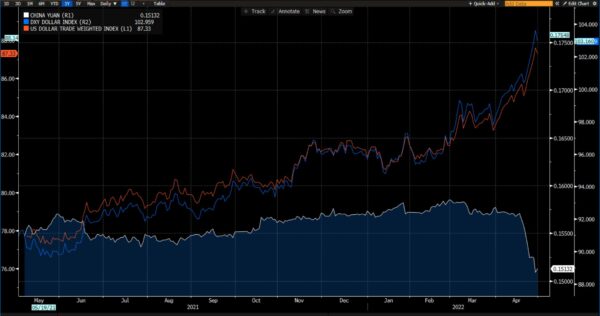April 2022 will go down in history as a milestone that has only been seen on three previous occasions since 1973. A month in which the S&P500 Index and US Treasuries have fallen at the same time, 5% and 2% respectively. Additionally, the US dollar has appreciated against the main currencies with which it trades and reaches a new year high.
Years of monetary laughing gas have not diminished the strength of the US dollar as world reserve currency, rather the opposite. Now we witness the vacuum effect. Inflows into the US dollar in a period of risk aversion.

The PBOC, the Central Bank of China has had to give in and allow an aggressive devaluation of the yuan, although it tried to keep the currency stable via capital controls and a daily fixing. The government-programmed weakness of the yuan is probably designed to provide a boost to the Chinese economy in a slowdown and dissolve part of the yuan-denominated debt. However, it reduces the Chinese yuan’s appeal as an alternative to the US dollar as global investors may fear both the central bank fixing as well as the tight capital controls imposed in China.
It is not surprising, for example, that many commodity-exporting countries’ currencies have weakened against the US dollar despite rising exports and foreign exchange inflows. From the Norwegian krone to the currencies of major exporters, it seems only the Brazilian real appears to be holding strong… and that’s because it’s had several atrocious years, so it is more a bounce than an appreciation.
What we are experiencing is the “vacuum effect” that we have commented a few times.
In periods of complacency, the world’s central banks play at being the Federal Reserve without having the world’s reserve currency or the legal security and financial balance of the US. Many increase massively money supply without paying attention to the global and local demand for their currency, and in addition, governments issue more US dollar-denominated debt, hoping that low rates will make the financing of huge deficits affordable. All this, in turn, leads to the global demand for US dollars to increase, not because the Federal Reserve carries out a restrictive policy, but because the comparison with others shows the alternative fiat currencies are much worse.
It is very worrying that the European Central Bank is allowing the euro to get dangerously close to parity with the US dollar because of its obsession with staying far away from the normalization process of other central banks. The global demand for euros is falling, and the trade surplus that supported the European currency is diminishing. All those who defend a weak euro should look at reality. Empirical evidence shows that the eurozone does not export more due to a weak euro, but with products of higher added value. With a weak euro, imports skyrocket and become more expensive.
Thus, the US dollar has created the conditions to be the most demanded currency simply because other central banks have been much more reckless. It only took an inflationary process that the central banks themselves denied or called transitory to raise the alarm of a market with overly optimistic expectations.
The market is clearly in a period of weakness and risk aversion. The effect of the invasion of Ukraine is relevant, but clearly the greatest impact is monetary. A market that rose to record highs on the back of aggressive money printing now finds itself in a tough spot as rate hikes and the end of asset purchases by central banks loom.
The fact is that this fear of interest rate hikes has led, so far, to a single modest rise of just 0.25% in the US and none in Europe.
The North American economy has contracted 1.4% in the first quarter and leads analysts to revise downwards the estimates for 2022. At the same time, the European Union shows that its main economies are close to stagnation or recession, with very poor progress in the first trimester. China, additionally, puts under the umbrella of the covid-19 what is a structural slowdown due to the burst of the real estate bubble and the political intervention in the leading sectors. This severe slowdown calls into question the central banks’ commitment to raising rates, especially doing so the number of times estimated by the consensus. Central banks will have to choose between high inflation or a significant increase in the cost of borrowing from states that refuse to reduce their imbalances.
Many expected a collapse of the US dollar and a flight to other currencies for commodity trading. The reality has proven again that, in a “fire”, the US dollar is the house with most windows and doors. The reckless policies of other central banks make the alternative in fiat world impossible. Will cryptocurrencies take over? Maybe, but it is very far away.
Very excellent summary of the US$ relative to the other world’s currencies! Hyperinflation is coming along with a major economic depression!!!
Excellent Illustration about the strength of the dollar and especially the vulnerability of the Euro ! I’m a regular reader of your Blog. Thanks for educating us Deep Sir!